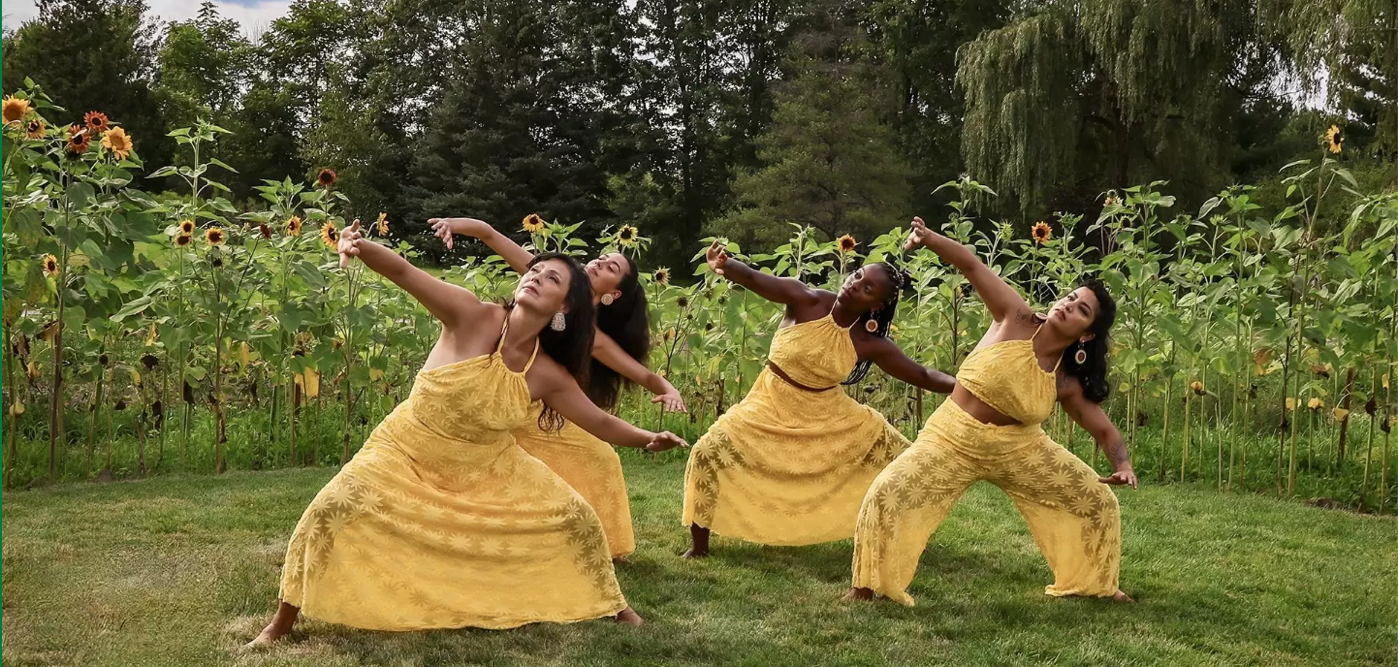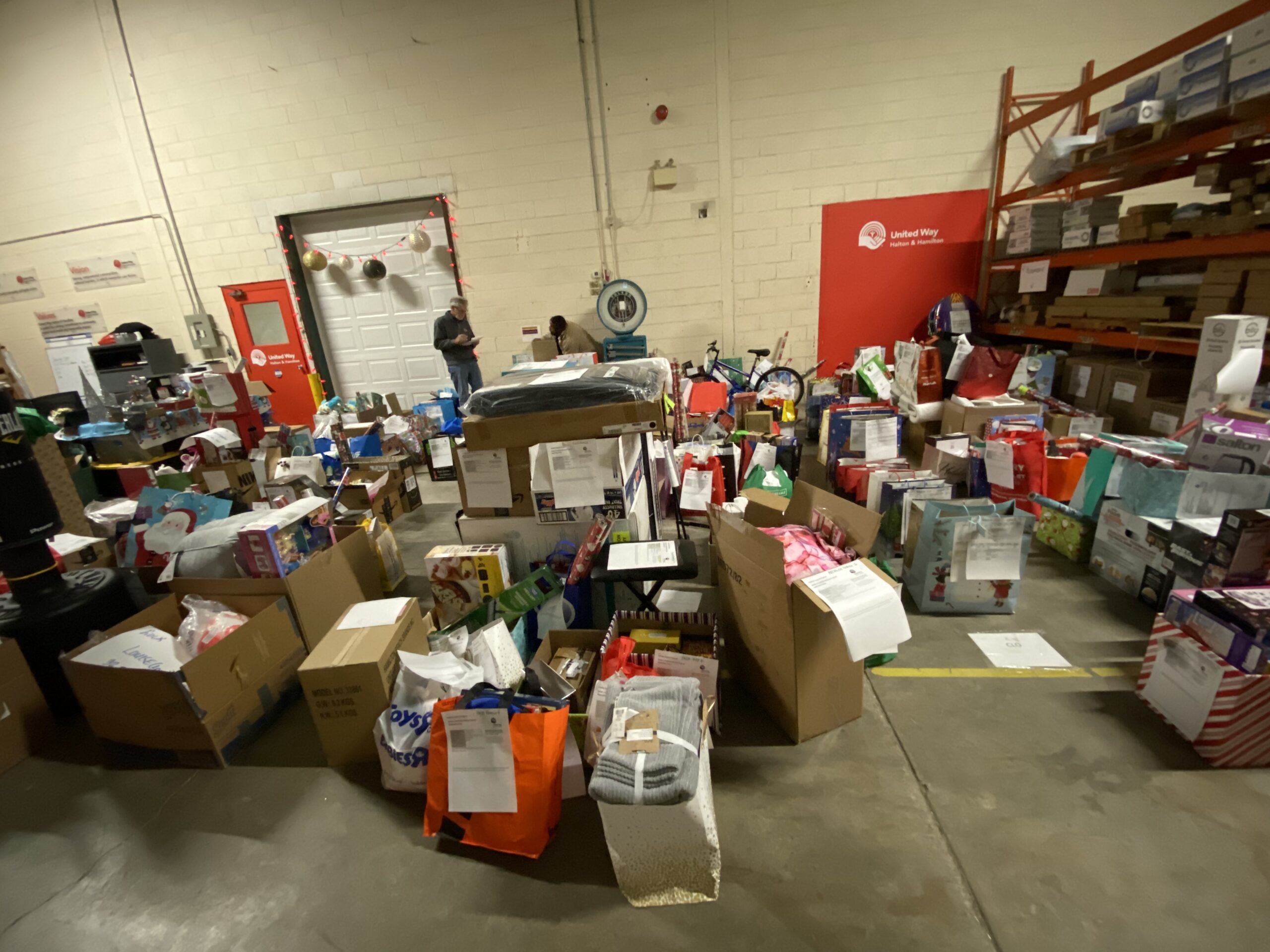This week and next, the Royal Botanical Gardens is hosting Santee Smith’s Kaha:wi Dance Theatre for a series of four performances of Oron’ónhta/Beings of Light on a stage grown specifically for the occasion.
That’s right, the stage was grown — of sunflowers. Oron’ónhta (pronounced o-lu‘un-da) means sunflower in Kanyen’kéha (Mohawk), and the performance features four dancers embodying sunflowers throughout their origin and life cycle.
Smith, who has just taken on her second term as chancellor of McMaster University and was appointed to the Order of Canada this year, created this performance to honour the connection between humans and plants, to embody and celebrate Indigenous knowledge, and to present all of that to her audiences. Based in Ohswé:ken (Six Nations of the Grand River) and Tkaronto (Toronto), Smith is a multidisciplinary artist, producer, and ceramicist, and Smith’s vision and aesthetic are informed by her goal of representing Indigenous knowledge visually.
Reaching that goal is a long process; for each of Smith’s productions, cultural research is the first step. There’s research with Indigenous scholars and at places like the Woodland Cultural Centre, and with people in the community, such as language speakers.
That first step can take anywhere from one to four years.
And then, says Smith, all of that knowledge “gets embedded in the dance; embodying that knowledge comes out in the performance, the design, the music. It’s all integrated and woven into what we do.” Embodiment is fundamental to Indigenous philosophy, Smith explains. “It’s the connection between mind and body. The body is really part of holding knowledge, and connecting us to land, nature, and our extended kinship.”
Extended kinship means not just humans, but non-human entities: animals and plants alike. And embodiment means representing the land, nature, or any non-human entities with one’s own body, as well as through the music in a production and in the design of the stage and props. On top of that, there are layers of knowledge in Smith’s work, layers of representation and connections.
For Oron’ónhta, for example, the idea for which came to Smith during the pandemic, one layer of knowledge begins with the sunflower itself — starting with the seed. Smith is a gardener, planting sunflowers in April from seeds, and tending them through their life cycle as they grow. That cycle of life is an important layer of Rotinonhsión:ni horticultural practice.
Then there’s the connection with the Rotinonhsión:ni (Creation Story). The story has many tellings with some small variations in the story between different Six Nations and tellers.
For the Kanyen’kéhà:ka (the Mohawk people), the story begins in Karonhia:ke, Sky World, where there were sky beings. In the centre of Sky World was the Tree of Life, with many kinds of fruit growing on it; the flowers glowed, giving Sky World their light.
Though the sky beings were not meant to disturb the tree, a pregnant woman by the name of Atsi’tsiaka:ion one day asked for tea made of the Tree of Life’s roots. Her husband began to dig at the roots, but the dirt caved in, taking the tree down with it. A hole was left in Sky World.
When Atsi’tsiaka:ion went to see what happened, she tumbled down through the hole. As she was falling, she grabbed seeds from around the celestial tree and from its roots. And so many now call her Sky Woman.
As she fell to the landless water below, a flock of birds caught her, lowering her down gently. A giant turtle in the water told the birds that his shell would support her, that the birds could put her on his back. And so they did. That is why North America is called Turtle Island by many.
After thanking the creatures, Atsi’tsiaka:ion told them that she needed land; the animals took it in turn to bring her dirt from the bottom of the ocean. With that dirt, she created land, which became her home; the seeds she brought from Sky World were corn, beans, squash, sacred tobacco, strawberries, sunflower. These plants became her medicine.
For longer versions of the creation story, read here or here.
So sunflowers are part of that original connection with Sky World, with Turtle Island’s creation. Another important layer.
Sunflowers were traditionally used in horticultural practice as companion plants; they are protectors and soil generators of gardens. They are planted “usually on the outskirts, on the northern side of fields to protect corn — birds will go to the sunflower seeds before going to the crops,” Smith notes. “This is Rotinonhsión:ni science which included the cultivation of various strains of sunflower, and the understanding of the interconnectedness to nature was part of our way of living and doing in the world.”
That interconnectedness is not only between humans, plants, and animals, it’s also between the plants and animals themselves. “Like sisters,” says Smith. “[It’s] that kinship connection. Every living entity has a role and responsibility, including the plants and animals.”
Another layer that was woven into the performance.
Of course, the stage itself is a layer of sorts, that living stage of sunflowers that was grown from seed to plant. In 2020, Smith planted her own 360° sunflower stage at Talking Earth Studio and Garden, her property in Ohswé:ken, hand-sowing over 400 flowers, taking part in that history of cultivating sunflowers on Turtle Island.
During the pandemic, Smith and her dancers worked at Talking Earth Studio and Garden, created videos (with #growingastage on social media), and programmed a digital sunflower concert. After that, she put out the call: “If you grow us a sunflower stage, we will come and dance in it!”
Smith reached out the Royal Botanical Gardens, and they came out to Six Nations to see a community performance — and then began to grow Smith and the Kaha:wi Theatre their sunflower stage. Smith is excited to see RBG’s take on it.
As for the performance itself, how exactly will the dancers embody sunflower seeds?
It’s through gesture and movements, of course, but Smith studies and celebrates natural pathways and patterning in creating the dances. Sunflowers, for instance, are heliotropic, so parts of the performance have movements representing the pathway of the sun, or movements of the leaves in the breeze. The sunflower embodies the spiral pathway, for example — the seeds in a sunflower follow the pattern of the Fibonacci sequence.
Oron’ónhta/Beings of Light will take the audience through the whole journey of the sunflower, from Sky World down to Turtle Island, from the seed landing, being sown “to full manifestation — blossoming, the decay of the plant back to earth, and regenerating…back to pure spirit form, when we come out as characters,” describes Smith. “We transform into the spirit of the seed, these characters that are non-human, and of course, it’s a celebration dance.” A celebration of the interconnectedness between us all, of the cyclical nature of life, of the energy that sunflowers hold.
Also featured in this performance is a ceramic vessel, one made by her father, Steve T. Smith. Smith comes from a family of potters, beginning with her grandmother, Elda “Bun” Smith, who taught herself the old ways of making pottery, and then passed that knowledge on to her family. The vessel in Oron’ónhta is a contemporary version of a four-cornered vessel, each corner decorated with a face, as well as floral designs on the sides. “Those become our seed faces; our sunflower seed face gestures come from the pot,” says Smith. Yet another layer of knowledge, then, with family knowledge being represented, and another way of honouring the land and plant life, as the raw material for pottery comes, after all, from the land.
For one more piece of embodied knowledge, Smith notes, “Another way to describe plants is life-sustainers; and another way of describing feminine force is life-sustainers.” No mistake, then, that the dancers performing Oron’ónhta are all women: Smith, Katie Couchie, Nickeshia Garrick, and Irma Villafuerte. And while the women are dancing with Smith’s framing, aesthetic, and choreography, each dancer brings themselves to the performance.
Each dancer is “unique and individual, we have our own embodied practice, and bring our own energy to the whole dance. That’s important to me and embodies Rotinonhsión:ni understanding; individuality within a collective…it’s a fundamental philosophy,” explains Smith. “We bring this understanding into the dance.” And as with the concept of interconnectedness, it’s not just about humans. “The collectiveness is also with other humans, non-humans, and nature.”
Oron’ónhta is a celebration of life and the deep connections between humans and the natural world; it will embody that rich tapestry of Rotinonhsión:ni knowledge and the interconnectedness of all living things. And, says Smith, “It’s a group of powerful, generous, beautiful artists who are giving a glorious performance. We love dancing together, and it’s good energy.”
There are four options for viewing Oron’ónhta/Beings of Light at the Royal Botanical Gardens; two are drop in performances on Sat., Sept. 23 at 3 p.m., and Sun., Sept. 24 at 1 p.m. at Hendrie Park. Admission to these drop-in performances is included with garden admission or membership. There are also two “enhanced” experiences, both of which require pre-registration. The first is a performance with an Indigenous culinary experience, with a build-your-own-plate buffet-style meal from Chef Destiny Moser of the Cedar Spoon on Sat., Sept. 23 at 6 p.m. The meal will include salad, side, Land and Sky entrée options, and dessert; registration can be done here and costs $126. The second is the performance followed by a Q&A period with Santee Smith, on Sun., Sept. 24 at 3:30 p.m. You can register here; cost is garden admission or membership plus an add-on ticket for $11.30.
For more information on Santee Smith and Kaha:wi Dance Theatre, go to kahawidance.org.





